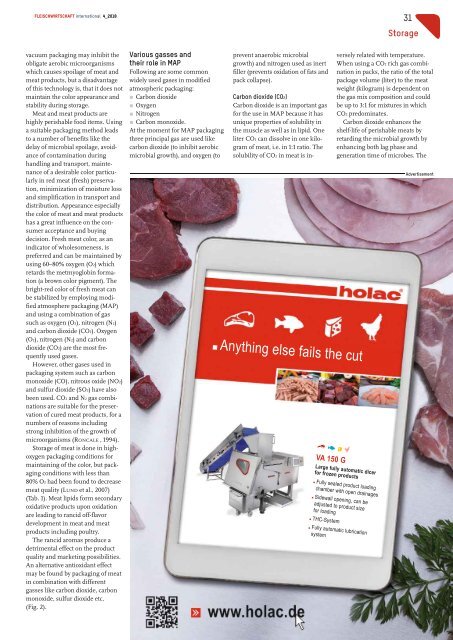FLEISCHWIRTSCHAFT international_04_2018
- No tags were found...
You also want an ePaper? Increase the reach of your titles
YUMPU automatically turns print PDFs into web optimized ePapers that Google loves.
Fleischwirtschaft <strong>international</strong> 4_<strong>2018</strong><br />
31<br />
Storage<br />
vacuum packaging may inhibit the<br />
obligate aerobic microorganisms<br />
which causes spoilage of meat and<br />
meat products, but a disadvantage<br />
of this technology is, that it does not<br />
maintain the color appearance and<br />
stability during storage.<br />
Meat and meat products are<br />
highly perishable food items. Using<br />
a suitable packaging method leads<br />
to a number of benefits like the<br />
delay of microbial spoilage, avoidance<br />
of contamination during<br />
handling and transport, maintenance<br />
of a desirable color particularly<br />
in red meat (fresh) preservation,<br />
minimization of moisture loss<br />
and simplification in transport and<br />
distribution. Appearance especially<br />
the color of meat and meat products<br />
has a great influence on the consumer<br />
acceptance and buying<br />
decision. Fresh meat color, as an<br />
indicator of wholesomeness, is<br />
preferred and can be maintained by<br />
using 60–80% oxygen (O2) which<br />
retards the metmyoglobin formation<br />
(a brown color pigment). The<br />
bright-red color of fresh meat can<br />
be stabilized by employing modified<br />
atmosphere packaging (MAP)<br />
and using a combination of gas<br />
such as oxygen (O2), nitrogen (N2)<br />
and carbon dioxide (CO2). Oxygen<br />
(O2), nitrogen (N2) and carbon<br />
dioxide (CO2) are the most frequently<br />
used gases.<br />
However, other gases used in<br />
packaging system such as carbon<br />
monoxide (CO), nitrous oxide (NO2)<br />
and sulfur dioxide (SO2) have also<br />
been used. CO2 and N2 gas combinations<br />
are suitable for the preservation<br />
of cured meat products, for a<br />
numbers of reasons including<br />
strong inhibition of the growth of<br />
microorganisms (RONCALE , 1994).<br />
Storage of meat is done in highoxygen<br />
packaging conditions for<br />
maintaining of the color, but packaging<br />
conditions with less than<br />
80% O2 had been found to decrease<br />
meat quality (LUND et al., 2007)<br />
(Tab. 1). Meat lipids form secondary<br />
oxidative products upon oxidation<br />
are leading to rancid off-flavor<br />
development in meat and meat<br />
products including poultry.<br />
The rancid aromas produce a<br />
detrimental effect on the product<br />
quality and marketing possibilities.<br />
An alternative antioxidant effect<br />
may be found by packaging of meat<br />
in combination with different<br />
gasses like carbon dioxide, carbon<br />
monoxide, sulfur dioxide etc.<br />
(Fig. 2).<br />
Various gasses and<br />
their role in MAP<br />
Following are some common<br />
widely used gases in modified<br />
atmospheric packaging:<br />
r Carbon dioxide<br />
r Oxygen<br />
r Nitrogen<br />
r Carbon monoxide.<br />
At the moment for MAP packaging<br />
three principal gas are used like<br />
carbon dioxide (to inhibit aerobic<br />
microbial growth), and oxygen (to<br />
prevent anaerobic microbial<br />
growth) and nitrogen used as inert<br />
filler (prevents oxidation of fats and<br />
pack collapse).<br />
Carbon dioxide (CO2)<br />
Carbon dioxide is an important gas<br />
for the use in MAP because it has<br />
unique properties of solubility in<br />
the muscle as well as in lipid. One<br />
liter CO2 can dissolve in one kilogram<br />
of meat, i.e. in 1:1 ratio. The<br />
solubility of CO2 in meat is inversely<br />
related with temperature.<br />
When using a CO2 rich gas combination<br />
in packs, the ratio of the total<br />
package volume (liter) to the meat<br />
weight (kilogram) is dependent on<br />
the gas mix composition and could<br />
be up to 3:1 for mixtures in which<br />
CO2 predominates.<br />
Carbon dioxide enhances the<br />
shelf-life of perishable meats by<br />
retarding the microbial growth by<br />
enhancing both lag phase and<br />
generation time of microbes. The<br />
Advertisement

















